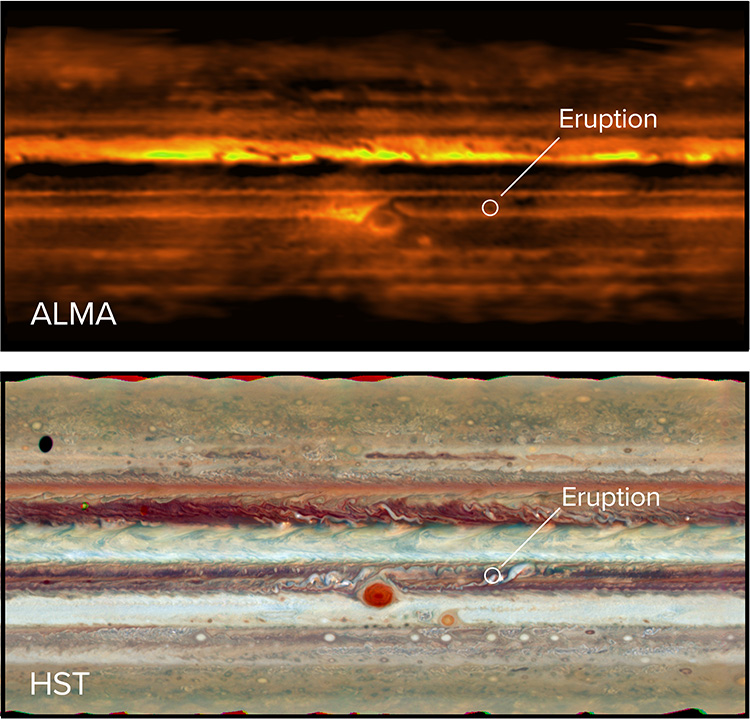Ammonia gas below Jupiter’s cloud deck. Image: ALMA (ESO/NAOJ/NRAO), I. de Pater et al.; NRAO/AUI NSF, S. Dagnello
In a first, scientists watched an energetic eruption on Jupiter by peering some 30 miles under the clouds that enshroud the planet. The observations “provide a crucial, hitherto missing, link” in theories about the hidden dynamics that shape Jupiter, according to a new study.Jupiter’s mesmerizing storms and colorful ribbons of gas make it one of the most photogenic objects in space, in the visible light spectrum at least. But to gaze below its ammonia-ice clouds, scientists need to use radio wave observatories like Chile’s Atacama Large Millimeter/submillimeter Array (ALMA).In early January 2017, scientists led by Imke de Pater, a UC Berkeley professor emerita of astronomy, used ALMA to check out a small bright white plume in Jupiter’s Southern Equatorial Belt that had been detected by amateur astronomer Phil Miles days earlier. These plumes, or eruptions, are thought to be intense storms breaking out below the cloud deck, which can generate lightning like thunderstorms on Earth.“ALMA enabled us to make a three-dimensional map of the distribution of ammonia gas below the clouds,” de Pater said in a statement. “And for the first time, we were able to study the atmosphere below the ammonia cloud layers after an energetic eruption on Jupiter.”The plume spilled over the cloud tops of Jupiter, bringing ammonia from the lower layers with it. It evolved into “a large-scale disruption” that was observed by Hubble Space Telescope, the Very Large Telescope in Chile, and several telescopes in Hawai’i, de Pater’s team said in a forthcoming study in the Astronomical Journal.The multi-wavelength view of the eruption yielded support for what's known as the “the moist convection theory,” which suggests that these plumes originate in a water layer located 50 miles below Jupiter’s surface clouds. As liquid water condenses in this region, it emits heat that carries plumes of ammonia to the top cloud layer."Our ALMA observations are the first to show that high concentrations of ammonia gas are brought up during an energetic eruption," de Pater said. “The combination of observations simultaneously at many different wavelengths enabled us to examine the eruption in detail.”
These plumes, or eruptions, are thought to be intense storms breaking out below the cloud deck, which can generate lightning like thunderstorms on Earth.“ALMA enabled us to make a three-dimensional map of the distribution of ammonia gas below the clouds,” de Pater said in a statement. “And for the first time, we were able to study the atmosphere below the ammonia cloud layers after an energetic eruption on Jupiter.”The plume spilled over the cloud tops of Jupiter, bringing ammonia from the lower layers with it. It evolved into “a large-scale disruption” that was observed by Hubble Space Telescope, the Very Large Telescope in Chile, and several telescopes in Hawai’i, de Pater’s team said in a forthcoming study in the Astronomical Journal.The multi-wavelength view of the eruption yielded support for what's known as the “the moist convection theory,” which suggests that these plumes originate in a water layer located 50 miles below Jupiter’s surface clouds. As liquid water condenses in this region, it emits heat that carries plumes of ammonia to the top cloud layer."Our ALMA observations are the first to show that high concentrations of ammonia gas are brought up during an energetic eruption," de Pater said. “The combination of observations simultaneously at many different wavelengths enabled us to examine the eruption in detail.”
Advertisement
